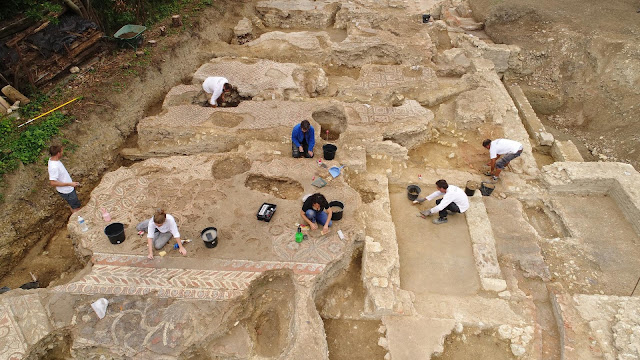In a remarkable archaeological discovery, a series of stunning mosaics dating back 1,800 years have been uncovered during ongoing excavations in the historic city of Pompeiopolis, situated in the northern district of Kastamonu, Turkey. These captivating relics, painstakingly preserved, are set to captivate both history enthusiasts and curious tourists, offering a glimpse into the past.
The Ministry of Culture and Tourism has been leading the excavation efforts in collaboration with the Karabük University Faculty of Letters and the esteemed Archaeology Department Lecturer, Mevlüt Eliuşük. The project’s scope encompasses Pompeiopolis, a sprawling Roman metropolis that once stood as a prominent symbol of the Paphlagonia region and thrived as a bustling urban center.

The focus on the palace section of Pompeiopolis, particularly the Zımıllı Tepe neighborhood, has yielded a momentous revelation. Here, a grand Roman palace has emerged, covering an expansive area of approximately 1,600 square meters. This architectural marvel stands as a testament to the ingenuity of its era, boasting an array of private chambers and intricate decorative elements.
According to Eliuşük, Pompeiopolis reigned as the heart of the region during the second century A.D. The legacy of this ancient city allows us to witness the magnificent remnants of the Roman Empire that once flourished within its boundaries.
Central to these excavations is the enduringly significant Roman villa. Though fountains and complex infrastructure that once adorned its interiors now exist solely as foundational remnants, the true highlight lies in the exquisite mosaics that grace the villa’s floors. These artworks, undoubtedly the crown jewels of the findings, offer a glimpse into the artistic prowess of the late second to early third century A.D.

Eliuşük explains that these magnificent mosaics, which depict scenes from the villa’s early history, have been uncovered as spectacles. Despite the passage of time, they continue to reveal their beauty, including a mosaic featuring a female figure alongside a letter believed to have been written by her husband. Remarkably, these mosaics are estimated to be nearly 1,800 years old, providing an unparalleled insight into the artistry of their era.
Under protective roofing, archaeologists have diligently conserved these priceless artifacts, preparing them for public display in 2023. As this year’s excavations draw to a close, Eliuşük expresses his vision: “We are poised to transform this historically significant site into a haven for the curious mind. Guided walking tours are in the works, ensuring that people can experience the splendor of Pompeiopolis firsthand.”
Eliuşük adds, “History enthusiasts have long been captivated by Pompeiopolis and marveled at our exhibits. However, the excavation site remains a hidden treasure. The villa has been our focal point for the past two years, and our aim is to create an accessible space for everyone to explore.” With this exciting find, the past comes alive, inviting us to step back in time and immerse ourselves in the grandeur of Pompeiopolis.



